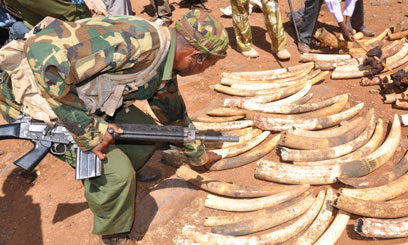NAIROBI, Jul 15 – Kenya will next week burn nearly five tonnes of ivory poached in eastern and southern Africa and stockpiled for nearly a decade, an official announced on Thursday.
The 4.967 tonnes (10,950 pounds) of elephant tusks were seized in Singapore in 2002 and brought to Kenya by the Lusaka Agreement Task force (LATF) – which is headquartered in Kenya – in 2004 for investigation purposes.
They have been stored since then at the KWS field training school in Manyani, Tsavo West National Park.
“Investigations revealed that the ivory could have originated from savanna elephant populations in Malawi, Tanzania and Zambia,” Lusaka Agreement Task Force Director Bonaventure Ebayi indicated.
Having concluded the investigations, the Lusaka Agreement governing council resolved that the disposal of the ivory be undertaken in accordance with the convention on international trade in endangered species of wild fauna and flora (CITES) regulations.
Mr Ebayi said the burning of the ivory follows an agreement reached by Malawi, Tanzania and Zambia in May in Nairobi.
The task force is charged with implementing the Lusaka Agreement designed to help African law enforcement agencies tackle wildlife smuggling.
Wednesday’s burning will be the second in Kenya, which in 1989 torched 12 tonnes of ivory. Zambia also burnt smuggled tusks in 1992.
Mr Ebayi said the measure was no different from the destruction of any other contraband.
The Lusaka Agreement on Cooperative Enforcement Operations Directed at Illegal Trade in Wild Fauna and Flora was adopted in September 1994 and currently there are seven parties to the agreement.
These are the Republics of Congo Brazzaville, Kenya, Tanzania, Uganda, Zambia, Liberia and Lesotho.
South Africa, Ethiopia and Swaziland are signatories.
Africa is home to 472,269 elephants whose survival is threatened by poaching and illegal trade in game trophy.
(Agence France Presse contributed to this report)

No comments:
Post a Comment